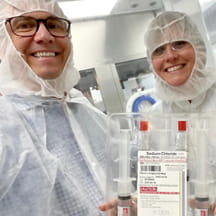The numbers are eye-opening. A recent survey of 330 hospitals nationwide shows the impact of drug shortages on children's hospitals significantly outweighs the impact on their adult counterparts:
- Pediatric hospitals spent an average of 50 hours per week managing drug shortages as compared to 35 hours per week for other hospitals.
- Children's hospitals were three-and-a-half times more likely to hire additional pharmacists and twice as likely to hire additional buyers and technicians due to shortages.
- Shortages of certain drug classes were especially severe for children's institutions—they include plasma products (59% of pediatric hospitals impacted versus 27% for others) and antineoplastics (52% versus 11%).
“Having this data to now highlight the disproportionate impact of drug shortages is a big asset as we continue to work with industry partners to increase the resiliency of the pediatric pharmaceutical supply chain,” says Terri Lyle Wilson, vice president of pharmacy at Children's Hospital Association (CHA).
Year-long effort reveals 30 essential drugs
The statistics are the culmination of a year-long project dedicated to investigating the effect of drug shortages on self-governed pediatric hospitals—the Pediatric Drug Shortages Project (PDSP). Vizient and CHA collaborated on the project, aiming to not only assess shortage impacts but to also analyze strategies for mitigating them. The result is a list of 30 essential pediatric drug products that would disproportionately affect pediatric hospitals in the event of a shortage.
Though the list wasn't publicized to protect the integrity of the supply chains of these vital drugs, PDSP leadership has access to on-demand monitoring to keep tabs on market parameters for these medications. Additionally, the project calls for mitigation strategies to further protect supply lines. Among them, additional manufacturers are needed for these drugs, working with manufacturers to prioritize pediatric preferred formulations and leveraging outsourcing facilities (503B pharmacies) to compound large batches of medications, decreasing the time to market during a shortage.
Strategies to limit risk to children's hospitals
While the project leaders work to mitigate the risk of shortages for those 30 essential drugs, the research also indicates that children's hospitals can help themselves in preserving supplies of all medications. Perhaps the biggest area of improvement for health care professionals is curtailing anticipatory purchasing.
The researchers conducted site visits of a handful of participating children's hospitals and found further effective shortage mitigation strategies, including:
- Improved inventory management. Carving out a dedicated space for the surplus of short drugs and using a visual demand tracking process (such as the Kanban system) for drug storage and procurement are among strategies to more accurately track drug quantities on hand.
- Enhanced communication. Building close working relationships with distribution representatives and standardizing internal communication protocols around drug supply issues are key.
- Task forces. Having a drug shortage task force or committee in place is recognized as a best practice by the American Society of Health-System Pharmacists (ASHP). Nearly 40% of CHA members responding to the survey had not yet implemented one.
- Compounding safety. One participating children's hospital does not outsource compounding of a drug until it can first demonstrate the ability to compound in-house and performs its own sterility, endotoxin and stability testing. Another performs independent quality testing for all drugs that are compounded in-house.


